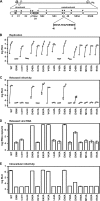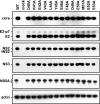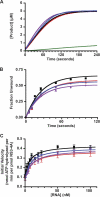The acidic domain of hepatitis C virus NS4A contributes to RNA replication and virus particle assembly
- PMID: 21047963
- PMCID: PMC3020511
- DOI: 10.1128/JVI.01889-10
The acidic domain of hepatitis C virus NS4A contributes to RNA replication and virus particle assembly
Abstract
Hepatitis C virus NS3-4A is a membrane-bound enzyme complex that exhibits serine protease, RNA helicase, and RNA-stimulated ATPase activities. This enzyme complex is essential for viral genome replication and has been recently implicated in virus particle assembly. To help clarify the role of NS4A in these processes, we conducted alanine scanning mutagenesis on the C-terminal acidic domain of NS4A in the context of a chimeric genotype 2a reporter virus. Of 13 mutants tested, two (Y45A and F48A) had severe defects in replication, while seven (K41A, L44A, D49A, E50A, M51A, E52A, and E53A) efficiently replicated but had severe defects in virus particle assembly. Multiple strategies were used to identify second-site mutations that suppressed these NS4A defects. The replication defect of NS4A F48A was partially suppressed by mutation of NS4B I7F, indicating that a genetic interaction between NS4A and NS4B contributes to RNA replication. Furthermore, the virus assembly defect of NS4A K41A was suppressed by NS3 Q221L, a mutation previously implicated in overcoming other virus assembly defects. We therefore examined the known enzymatic activities of wild-type or mutant forms of NS3-4A but did not detect specific defects in the mutants. Taken together, our data reveal interactions between NS4A and NS4B that control genome replication and between NS3 and NS4A that control virus assembly.
Figures







Similar articles
-
Hepatitis C virus NS2 protein contributes to virus particle assembly via opposing epistatic interactions with the E1-E2 glycoprotein and NS3-NS4A enzyme complexes.J Virol. 2009 Sep;83(17):8379-95. doi: 10.1128/JVI.00891-09. Epub 2009 Jun 10. J Virol. 2009. PMID: 19515772 Free PMC article.
-
The C terminus of hepatitis C virus NS4A encodes an electrostatic switch that regulates NS5A hyperphosphorylation and viral replication.J Virol. 2007 Sep;81(17):8905-18. doi: 10.1128/JVI.00937-07. Epub 2007 Jun 20. J Virol. 2007. PMID: 17581983 Free PMC article.
-
The acidic domain of the hepatitis C virus NS4A protein is required for viral assembly and envelopment through interactions with the viral E1 glycoprotein.PLoS Pathog. 2019 Feb 7;15(2):e1007163. doi: 10.1371/journal.ppat.1007163. eCollection 2019 Feb. PLoS Pathog. 2019. PMID: 30730994 Free PMC article.
-
Nonstructural protein 3-4A: the Swiss army knife of hepatitis C virus.J Viral Hepat. 2011 May;18(5):305-15. doi: 10.1111/j.1365-2893.2011.01451.x. Epub 2011 Mar 23. J Viral Hepat. 2011. PMID: 21470343 Review.
-
The hepatitis C virus NS3 proteinase: structure and function of a zinc-containing serine proteinase.Antivir Ther. 1998;3(Suppl 3):99-109. Antivir Ther. 1998. PMID: 10726060 Review.
Cited by
-
Micro-PET imaging of hepatitis C virus NS3/4A protease activity using a protease-activatable retention probe.Front Microbiol. 2022 Nov 4;13:896588. doi: 10.3389/fmicb.2022.896588. eCollection 2022. Front Microbiol. 2022. PMID: 36406412 Free PMC article.
-
HCV core residues critical for infectivity are also involved in core-NS5A complex formation.PLoS One. 2014 Feb 12;9(2):e88866. doi: 10.1371/journal.pone.0088866. eCollection 2014. PLoS One. 2014. PMID: 24533158 Free PMC article.
-
Incorporation of hepatitis C virus E1 and E2 glycoproteins: the keystones on a peculiar virion.Viruses. 2014 Mar 11;6(3):1149-87. doi: 10.3390/v6031149. Viruses. 2014. PMID: 24618856 Free PMC article. Review.
-
Determination of Critical Requirements for Classical Swine Fever Virus NS2-3-Independent Virion Formation.J Virol. 2019 Aug 28;93(18):e00679-19. doi: 10.1128/JVI.00679-19. Print 2019 Sep 15. J Virol. 2019. PMID: 31292243 Free PMC article.
-
Polyprotein-Driven Formation of Two Interdependent Sets of Complexes Supporting Hepatitis C Virus Genome Replication.J Virol. 2015 Dec 30;90(6):2868-83. doi: 10.1128/JVI.01931-15. J Virol. 2015. PMID: 26719260 Free PMC article.
References
-
- Adair, R., et al. 2009. Expression of hepatitis C virus (HCV) structural proteins in trans facilitates encapsidation and transmission of HCV subgenomic RNA. J. Gen. Virol. 90:833-842. - PubMed
-
- Beran, R. K., M. M. Bruno, H. A. Bowers, E. Jankowsky, and A. M. Pyle. 2006. Robust translocation along a molecular monorail: the NS3 helicase from hepatitis C virus traverses unusually large disruptions in its track. J. Mol. Biol. 358:974-982. - PubMed
Publication types
MeSH terms
Substances
Grants and funding
LinkOut - more resources
Full Text Sources

